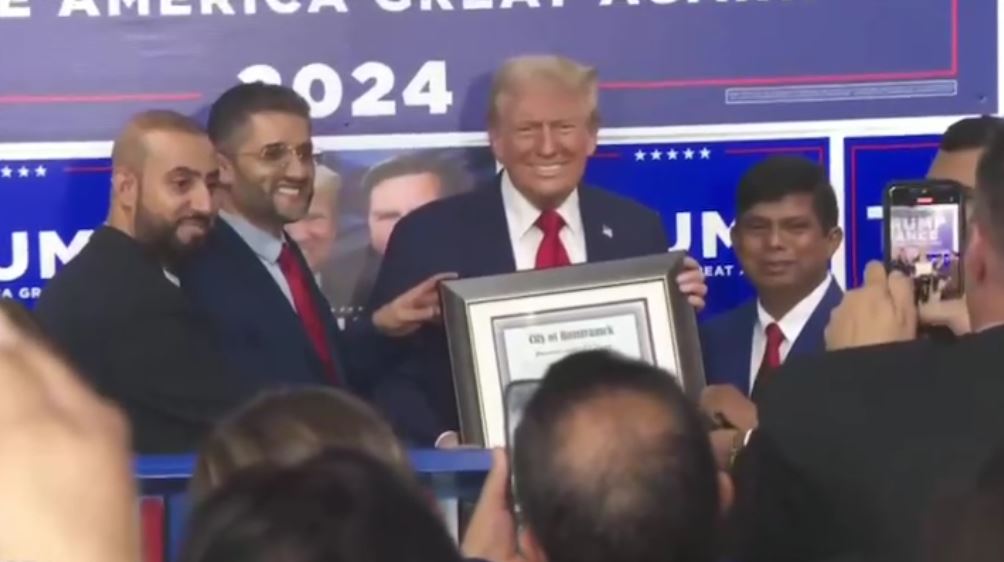On a recent visit to Hamtramck, Michigan, President Donald Trump received a warm welcome and a significant gesture of appreciation from Mayor Amer Ghalib and the city’s Muslim-majority government. Hamtramck is known for being the only city in the United States with a Muslim majority, a distinction that carries considerable pride for its residents. With a population density that makes it the most packed municipality in Michigan, Hamtramck represents a unique blend of cultural diversity and community engagement, especially highlighted by its elected officials, all of whom are Muslim. This visit by President Trump underscores the complex dynamics of politics and identity in such communities, drawing attention not just to local leadership but to the broader political climate in the nation.
During the rally held in the city, Mayor Ghalib, accompanied by other city officials, presented President Trump with a certificate of appreciation. This moment was intended to symbolize the collaboration and acknowledgment of different cultures within Hamtramck, as well as to highlight Mayor Ghalib’s efforts to foster connections beyond typical partisan politics. In his speech, Ghalib expressed gratitude to the President, announcing that the event would be historic for their city, illustrating a sense of inclusivity and community pride. The gesture reflects Hamtramck’s identity as a microcosm of American diversity, where governance transcends religious and cultural boundaries, often challenging the broader national narrative.
Despite the significance of this event and its implications for inter-community relations, it went largely unreported both locally in Michigan and nationally. This silence raises questions about media coverage, particularly how stories involving intersecting identities in a politically charged environment are constructed or neglected. In a time when narratives about immigration and Muslim communities can be divisive, the muted response to Mayor Ghalib’s commendation of the President may reflect deeper societal biases or a tendency to overlook positive interactions that counteract prevailing stereotypes. The lack of coverage could suggest an inclination to focus on more sensational stories, potentially overlooking the peaceful coexistence and mutual respect that can exist within diverse communities.
The gathering not only highlighted the local political landscape but also served as a touchpoint for broader discussions about American identity. Hamtramck’s experience as a majority-Muslim city challenges monolithic views of both Islam and American politics. The meeting between President Trump and the city’s leaders symbolizes a potential for dialogue that transcends political affiliations, as it exemplifies how local government can navigate contentious national issues while striving to maintain community cohesion. This interaction poses a thought-provoking question regarding how different political narratives intersect with localized governance, particularly in areas where immigrants and minority populations form substantial parts of the demographic makeup.
Moreover, Mayor Ghalib’s proactive gesture towards President Trump signifies an effort to cultivate goodwill and constructive engagement at all levels of government, which may often be overshadowed by partisan rhetoric. In doing so, Ghalib and the Hamtramck city council illustrate the importance of local leaders in mediating and fostering relationships that lend hope for a more inclusive political atmosphere. Such initiatives can considerably impact public perception, not just in Hamtramck, but across diverse community settings and in the broader American landscape, encouraging individuals to seek common ground amidst differing viewpoints.
In conclusion, President Trump’s visit to Hamtramck and the subsequent award presented by Mayor Ghalib encapsulates the complex interplay of politics, community identity, and media representation in today’s America. Hamtramck serves as a vivid example of how local governance can challenge overarching narratives about diversity and political divisions. The largely unnoticed ceremony indicates a gap in media discourse on the positive representations of Muslim identities within American society. Ultimately, the event underlines the significance of local stories in shaping collective understanding and the urgent need for inclusive dialogues that celebrate diversity in all its forms.

